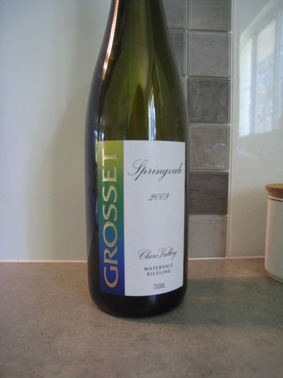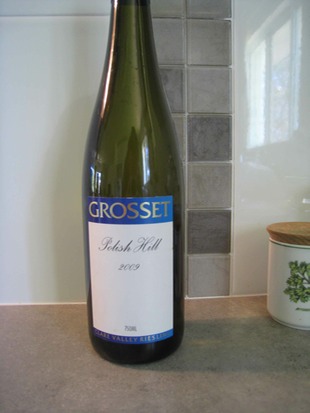Thursday, 10 September 2009
2009 Polish Hill Riesling
2009 Springvale Riesling
Here at the Little House of Concrete we tend to be a little light on for liquid refreshment to offer visitors.
Of course, if they’ll take a drink, there are plenty of options. When The Actor or The Scoffer lob on the doorstep we know they’ll accept a coffee and Madam has a couple of variations on the tea theme, but things pull up short if you’re looking for a non-alcoholic, non-tea or coffee option.
That fact was reinforced when we had a visit from The Celebrity Spotter from the Movie Volunteers. We offered a tea or coffee, could have tempted her with a wine but she was driving and ended up providing glasses of freshly-filtered water. As our guest was leaving, Madam was apologetic about the lack of something in the way of non-alcoholic liquid refreshment.
“It’s all right,” she replied. “I like water. It’s my favourite drink.”
The reference to favourite drink somehow propelled me towards the wine rack, and a subsequent question regarding my favourite had me waving a bottle of Grosset Polish Hill Riesling that had, coincidentally arrived that morning.
While, at that point in time, I hadn’t tried either of the Grossets I’ve got a long-standing belief if I was forced to limit myself to a single grape variety, that variety would be Riesling, and while I’m partial to what I’ve sampled from Tasmania and South Australia’s Eden Valley and keen to try the styles coming out of Western Australia’s Great Southern region, if you forced me to specify a single region as well as a single variety the region would be Clare.
I think much of the appeal of Riesling is the fact that what you get in the glass is the direct result of what comes out of the vineyard filtered through winemakers’ skill and experience and there’s not much the winemaker can do to conceal faults in the fruit. While you can use oak barrels to add extra flavour components to a number of red varieties and some of the whites, Riesling doesn’t allow makers that luxury.
Actually, if you’re going to start playing around with Riesling you’re heading towards the upper end of the price range rather than turning dodgy material into something saleable.
We found a couple of examples of that when we were in the Clare Valley in November 2008. In almost every case, the first wine on offer was a Riesling and every one was wonderful. In some cases there was more than one. At Kilikanoon, for example there was Mort’s Block Riesling and Mort’s Reserve. The difference (apart from the $9 difference in price)?
The Reserve was made entirely from free-run juice from fruit sourced from selected rows from the vineyard. Once the free-run juice was gone, the rest went through the presses to go in with the rest of the must from the rest of the vineyard.
Free-run juice, in other words, is 100% grape juice, uninfluenced by skins, stalks or any other external influence. and both Grosset Rieslings are 100% free-run juice from 100% hand-picked fruit.

So, what’s the difference between the two vineyards?
Springvale vineyard sits at the highest point in the north-eastern corner of the Watervale sub-region with a thin crust of rich red topsoil over soft limestone, grey slate and shale. That soil produces sturdy vines, with chunky bunches of big berries, and lime green grapes that are bigger than those on the Polish Hill vines. The resulting wines, to quote the Grosset website are dry with a mineral edge, savoury, yet with a noticeable fullness and richness and pronounced riesling fruit flavour.
In contrast, the Polish Hill vineyard has sandy loam over clay, gravel, shale and slate on a ridge running north from Mount Horrocks, 460 metres above sea level. The soil isn’t very fertile, so the vines and berries are smaller and more concentrated than those of Springvale. As a result, you’d expect the Polish Hill to be leaner and more austere than its Watervale counterpart. Not that we’ll be doing too many comparative tastings, of course.
We tried the Springvale first, in honour of Madam’s sister’s birthday. Any excuse will do, and we’d given the bottle a whole two days to get over the road transport trauma. We lined it up with pan-fried mixed reef fillets, simple boiled potato, some broccoli and a couple of cherry tomatoes from the garden.
The nose was fairly restrained, inducing Madam to step away from the table. I’d already seen a tasting note describing the nose, decided it was pretty much on the money and stayed put. You’d expect that to change over time, of course.
While the wine’s still fairly restrained at present (naturally, it’s only a baby) there’s plenty of fruit on the palate, the regular lemon/lime notes and a nice slate/mineral texture to the wine. The acidity gives it a lingering finish and, given a suggested five to twelve years in the cellar there’s going to beimprovement as the wine opens up over time. That means five for the wine fridge and an appointment with another bottle some time around 2012.
Having tried the Springvale, I wasn’t in a hurry to sample the Polish Hill. I’d pencilled in an appointment with the fishmonger or dinner somewhere as possibilities. A phone call in early October changed that scenario. I’d been planning to contact my old flat-mate Mr Dave prior to heading down to catch Elvis Costello in Brisbane but had left it too late.
 The gentleman (and a true scholar and gentleman he was) had passed away the day before. He was a major influence on my emerging interest in wine in the seventies. Passing through Brisbane in 1979 I’d overnighted at his unit in Herston and had been introduced to his then-current Shiraz benchmark, sourced from Taylors in the Clare Valley and, if I recall correctly, labelled as Hermitage. Reflecting on that on Saturday afternoon I decided the Grosset Polish Hill would be a suitable start to the evening’s dinner proceedings.
The gentleman (and a true scholar and gentleman he was) had passed away the day before. He was a major influence on my emerging interest in wine in the seventies. Passing through Brisbane in 1979 I’d overnighted at his unit in Herston and had been introduced to his then-current Shiraz benchmark, sourced from Taylors in the Clare Valley and, if I recall correctly, labelled as Hermitage. Reflecting on that on Saturday afternoon I decided the Grosset Polish Hill would be a suitable start to the evening’s dinner proceedings.
Having opened the bottle, I was bemused by the nose. The nose, in fact, was almost conspicuous by its absence, some slight talcum powder characters, perhaps but not a great deal else at this stage.
Once I’d taken a sip, any reservations evaporated as quickly as surface water in a North Queensland pre-monsoon summer.
Unlike the nose, on the palate the wine was bursting with stunning lime characters - more or less lime on steroids - tightly coiled around a core of acidic minerality. We were taking our time over the wine, and it opened up very nicely as I went about putting the ingredients for the evening meal together.
Reflecting on the Good friends we have had and, good friends we’ve lost/ Along the way I took another sip and was reminded of another passed mate’s seal of approval as far as taste was concerned.
It made my tongue go hard.
Precisely, Lester. The sort of wine that makes your taste buds stand up and pay attention.
With five bottles left, one of which is, like its cousin/brother headed for Southport, I think I’ll be taking another look in about three years.
The way the wine opened up on Saturday evening promises considerable riches to come.